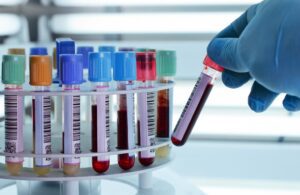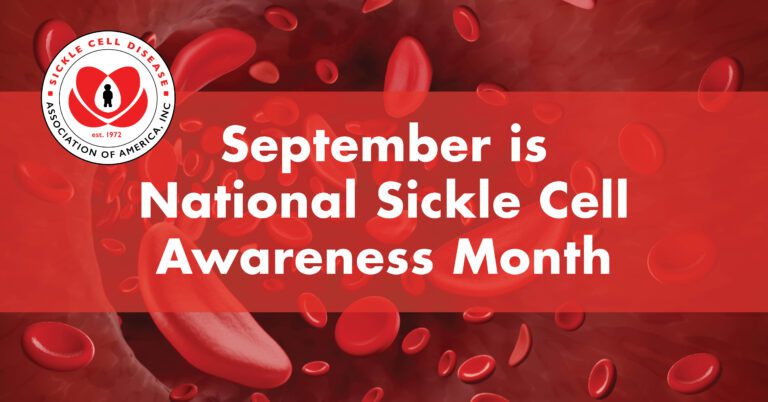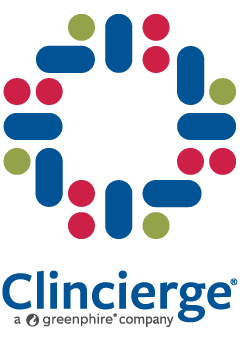In the United States (US), the month of September is National Sickle Cell Awareness Month. In 1976, the National Association for Sickle Cell Disease (NASCD) launched a series of public awareness campaigns and started reaching out to local, state, and federal legislators. In 1983, then-President Ronald Reagan signed Proclamation 5102 into law, proclaiming each September National Sickle Cell Awareness Month. In 1994, the NASCD rebranded as the Sickle Cell Disease Association of America (SSDAA).
Sickle cell disease is the term for a group of the most common genetic blood disorders in the US. SSD currently affects about 100,000 Americans. It is an inherited chronic condition causing the red blood cells in the body to harden and form a sickle shape. There are four main types of SCD:
- Hemoglobin SS or sickle cell anemia: The most common and severe form of SCD; a child must inherit copies of the Hb S gene from both parents, forming hemoglobin Hb SS; symptoms are much worse with this type
- Hemoglobin SC disease: The second most common form; a child must inherit the Hb C gene from one parent and the Hb S gene from the other; the anemia is less severe with this type
- Hemoglobin SB+ (beta) thalassemia: This form of SCD affects beta globin gene production; the size of red blood cells is reduced because less beta protein is produced; symptoms are less severe with this type
- Hemoglobin SB 0 (Beta-zero) thalassemia: This form also involves the beta globe gene and has similar symptoms to the most common form; the symptoms of beta-zero thalassemia are sometimes more severe and can result in a poorer prognosis
Whereas SCD affects those of many races, a disproportionate number of individuals with the disorder are of African or African American descent. The disease is also more prominent in Hispanic Americans from Central and South America and those of Middle Eastern, Asian, Indian, and Mediterranean descent.
Children must inherit one sickle cell gene from each parent to get SCD. If the child receives only one sickle cell gene, they have sickle cell trait (SCT). Individuals with SCT can pass the disease to their children via this trait. SCT is much more common in specific races, again found more often in African Americans, Hispanics, and those from Middle Eastern countries. For instance, up to 10% of all African Americans carry the sickle cell trait.
Ideally, sickle cell disease is diagnosed at birth. There is a state-sanctioned newborn screening test in all 50 states that includes testing for SCD. With an early diagnosis and continued treatment, more than 95% of those born with SCD will live to be adults.
The symptoms of SCD often vary in severity between individuals affected by the disease. These complications are chronic in nature, usually developing in the first few months of life, including:
- Anemia: chronic fatigue caused by a low level of oxygen in the blood
- Dactylitis: swelling in the hands and feet
- Jaundice: yellowing of the skin and the white parts of the eye
- Pain crisis: the most common reason for hospitalizations, these periods of immense pain affect both children and adults with SCD
Additional medical issues related to SCD include:
- Acute chest syndrome (ACS)
- Avascular necrosis (AVN)
- Blood clots
- Chronic pain episodes
- Fever and infection
- Kidney and liver problems
- Leg ulcers
- Organ damage
- Priapism
- Pulmonary hypertension
- Sleep-disordered breathing
- Splenic sequestration
- Stroke
- Vision loss
Because of the myriad of possible health issues associated with SCD, it is essential to have a care plan in place. This life-long healthcare strategy should involve industry professionals from various medical specialties to address all of the patient’s symptoms.
Patients with sickle cell disease often face several other challenges when dealing with this chronic medical condition.
- Higher Rates of Depression and Unemployment: A recent study of over 2,200 sickle cell disease patients between the ages of 15 and 45 found higher rates of unemployment and depression linked to the frequency of pain affecting SCD patients Almost half of those surveyed reported frequent pain equating to four or more pain crises in a 12-month period. Of these individuals, the rates of unemployment and depression were markedly higher for those with higher frequencies of pain crises.
- Lack of Empathy for Sickle Cell Patients from Healthcare Staff: Many patients with sickle cell disease report being dismissed by medical workers assisting them during a pain crisis. They are often made to sit for hours in a waiting room, as triage nurses put other patients with more significant needs before the SCD patient. Patients are often confused by the two spectrums of nursing care: they are either handed pain medication and told the pain will pass, or they are accused of visiting the facility again for a “fix” of pain medicine. Healthcare professionals should be better trained in the nuances of sickle cell disease to be empathetic to patients and work to find individualized courses of care.
Current Advances Against Sickle Cell Disease
Researchers have been working for decades to find a cure for SCD. There is currently only one cure for the disorder, and it is not an option for all patients.
In a bone marrow transplant, healthy cells are collected from a donor, most often a relative who is a close genetic match to the patient. The harvested bone marrow is transferred to the sickle cell patient, replacing the damaged marrow and producing healthy cells. This treatment has serious health risks to the patient and will not work for everyone with the disease. As with all treatment methods, the patient should be fully informed of the pros and cons by their doctor prior to the procedure to make an informed decision.
In the US, all new therapies must be approved by the United States Food and Drug Administration (FDA). This government entity oversees the entire approval process, from clinical trial protocol writing to all trial phases and market access. Currently, there are several FDA-treatment options for SCD:
- ADAKVEO: Novartis, approved in 2019; Intravenous (IV) infusion used to reduce the frequency of vaso-occlusive crises (VOCs) in adult and pediatric patients aged 16 years and older with SCD
- DROXIA: Bristol-Myers Squibb, 1998; Oral capsules to reduce the need for blood transfusions and the frequency of recurrent moderate to severe painful crises in patients with SCD
- ENDARI: Emmaus Life Sciences, approved in 2017; Oral powder to reduce oxidant damage to red blood cells in patients with SCD
- FERRIPOX: Chiesi Global Rare Diseases, approved in 2011; Oral tablets for use with transfusional iron overload in adult and pediatric patients 8 years of age and older with SCD or thalassemia syndromes
- OXBRYTA: Global Bood Therapeutics/Pfizer, approved in 2019; Oral capsules approved for use in adults and children 4 years of age and older with SCD
Researchers continue to look for new ways to cure SCD and to provide a cure for this chronic disorder. Recent advancements are being studied in the laboratory and clinical trials worldwide.
Gene therapy is one treatment method showing great promise. While seemingly expensive, many argue they are very cost-effective when looking at the improved quality of life for SCD patients and the reduced costs related to their lifelong medical care. In the future, the Children’s Hospital of Philadelphia (CHOP) hopes to be able to cure SCD with just one shot of gene therapy.

Researchers continue to look for new ways to cure SCD and to provide a cure for this chronic disorder. Recent advancements are being studied in the laboratory and clinical trials worldwide.
Gene therapy is one treatment method showing great promise. While seemingly expensive, many argue they are very cost-effective when looking at the improved quality of life for SCD patients and the reduced costs related to their lifelong medical care. In the future, the Children’s Hospital of Philadelphia (CHOP) hopes to be able to cure SCD with just one shot of gene therapy.Ideally, in order to discover new SCD treatment options, clinical trials must continue to attract, enroll, and retain study participants. Trial sponsors and clinical research organizations (CROs) who partner with a patient concierge company remove the emotional, financial, and logistical burdens related to study participation.
Upon trial enrollment, participants and their caregivers are paired one-on-one with a Clincierge Coordinator located in their time zone, who speaks their native language and understands their cultural nuances. The coordinator manages all components related to clinical trial participation, including but not limited to air/rail ticketing, ground transportation, hotel accommodations, stipend payments, and incidental reimbursements. The services are pre-planned and prepaid, so trial participants and their caregivers can relax and focus on receiving their treatment during the trial. These services increase access to clinical trials and much-needed participant diversity.
Also, the coordinator remains with the participants and their caregivers throughout the entirety of the trial, ensuring an improved participant experience, increased engagement with trial site staff, and study retention rates of over 95%.
- Read our blog focusing on equity and DEI in healthcare
- Read our blog discussing the US newborn screening program
SCD Hashtags: #SickleCellAwarenessMonth #sicklecellmatters2023 #SCDSCTMatters #SickleCell #SCDAA



